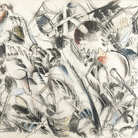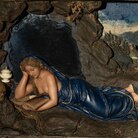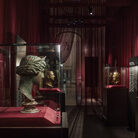Meraviglia senza tempo. Pittura su pietra a Roma nel Seicento

Dal 25 October 2022 al 29 January 2023
Roma
Luogo: Galleria Borghese
Indirizzo: Piazzale Scipione Borghese 5
Orari: dal martedì alla domenica dalle 9.00 alle 19.00. Ultimo ingresso alle ore 17.45. La biglietteria è aperta dalle ore 8.30 fino a 1 ora prima della chiusura del museo. La Galleria è chiusa il 25 dicembre e il 1 gennaio
Curatori: Francesca Cappelletti e Patrizia Cavazzini
Costo del biglietto: INTERO € 13,00 (ultimo turno € 8,00) RIDOTTO 18-25 anni € 2,00 GRATUITO minori di 18 anni PRENOTAZIONE OBBLIGATORIA per tutte le tipologie di biglietto € 2,00
Telefono per informazioni: +39 06 67233753
E-Mail info: ga-bor.info@beniculturali.it
Sito ufficiale: http://galleriaborghese.beniculturali.it
La mostra, pensata per attirare l’attenzione del pubblico su questa produzione di oggetti singolari, si inserisce in un percorso di ricerca iniziato nel 2021 con l’approfondimento del tema della Natura e del Paesaggio all’interno della collezione della Galleria.
È la collezione stessa, raccolta da Scipione Borghese nei primi tre decenni del Seicento, a presentare esempi di pittura su pietra di notevole interesse, mentre il contesto, la diversità di materiali impiegati nelle opere e la loro sintonia con le collezioni storiche non più esistenti di piante, animali e altre curiosità naturali, contribuisce a definire quel senso di meraviglia e di stupore che la accompagna da secoli.
Con oltre 60 opere provenienti da musei italiani e stranieri e da importanti collezioni private, Meraviglia senza tempo. Pittura su pietra a Roma tra Cinquecento e Seicento racconta, oltre all’ambizione all’eternità delle opere d’arte, del dibattito critico di un’epoca sensibile alla gara tra pittura e scultura, e anche di materiali primordiali, estratti dalle miniere, del loro percorso avventuroso fino alle botteghe degli artisti e fino al loro posto nelle collezioni, che diventano nuovi luoghi di questi dibattiti, in palazzi e ville sempre più ricchi di arredi, calamite per la produzione di beni di lusso.
Il percorso, articolato in otto sezioni, comincia con LA PIETRA DIPINTA E IL SUO INVENTORE, una necessaria premessa cinquecentesca che dimostra quanto l’uso di metalli e marmi come supporto alla pittura, la rendesse non solo capace di vincere il tempo, come la scultura, ma anche di rendere durevole la memoria di un personaggio: ce lo rivelano opere come il Ritratto di Filippo Strozzi (1550 c.) di Francesco Salviati, su marmo africano; quello di Cosimo de Medici (1560 c.) attribuito al Bronzino, su porfido rosso; o ancora il Ritratto di Papa Clemente VII con la barba (1531 c.) di Sebastiano del Piombo.
A partire dai primi decenni del Seicento, a seconda dei contesti geografici, la scelta dei materiali oscilla tra l’esigenza di garantire la conservazione delle opere e l’interesse per la capacità di questi materiali di evocare il soggetto stesso, di confrontarsi con l’Antico e con le altre arti, partecipando alla costruzione del significato dell’immagine.
Nella sezione UNA DEVOZIONE ETERNA COME IL MARMO, accanto a opere simili a talismani, alle quali era talvolta attribuito un potere magico di protezione dai mali fisici e spirituali, e dedicate alle immagini incorruttibili della devozione – spesso parte degli arredi delle camere da letto dei cardinali, come l’Adorazione dei magi (1600 – 1620) su alabastro di Antonio Tempesta o la Madonna con il Bambino e San Francesco (1605 c.) di Antonio Carracci dipinta su rame – troviamo dipinti su alabastro, lavagna, marmo di Carlo Saraceni, Orazio Gentileschi, Il Cavalier d’Arpino e molti altri.
Accanto a queste, una piccola parte dedicata a VENERE E LE SUE EROINE raccoglie tre immagini femminili del pittore toscano Leonardo Grazia dedicati a Ebe, Lucrezia e Cleopatra, realizzati nella prima metà del Cinquecento, due dei quali su lavagna; mentre nella sezione ANTICO E ALLEGORIA si trovano opere su marmo, lavagna e pietra di paragone, tutte dedicate a temi della poesia come l’Andromeda del Cavalier d’Arpino e l’Inferno con episodi mitologici di Vincenzo Mannozzi. Lucidi e scintillanti, gli sfondi dei dipinti riflettono come specchi l’immagine dello spettatore che, mentre la osserva, entra a far parte dell’opera.
UNA NOTTE NERA COME LA PIETRA comprende i dipinti su pietre scure (pietra di paragone, lavagna o marmo belga) che sfruttano il nero del supporto per ambientare scene notturne e per far risaltare le finitura dorate; mentre nelle sezioni DIPINGERE CON LA PIETRA/PAESAGGI E ARCHITETTURE e PIETRE PREZIOSE E COLORATE, i sorprendenti fondali offerti dalla pietra paesina e la preziosità di supporti come il lapislazzulo, usato per il mare e il cielo, vengono esaltati dall’intervento dell’artista: anche in questo caso il colore e le screziature delle pietre contribuiscono alla composizione dell’opera e a suggerire significati.
Sono spesso opere di artisti dalla formazione fiorentina, che sperimentano il supporto lapideo non solo in chiave di eternità della pittura, ma per evidenziare le possibilità decorative della materia.
È in questo contesto che si distingue Antonio Tempesta, singolare figura di raccordo fra Firenze e il mondo nordico. Pittore e incisore di grande fortuna durante il pontificato di Paolo V, il Tempesta è maestro nel trasformare con pochi e sapienti tocchi di pennello la pietra paesina in edifici, paesaggi e marine.
La discussione sulla durabilità delle opere d’arte si era inserita nel dibattito sul paragone tra scultura e pittura, ma nel corso del Seicento si infittisce il gioco fra arti sorelle: gli scultori usano marmi colorati e i pittori dipingono su pietra, mentre metalli e legni preziosi concorrono alla creazione di oggetti straordinari, come piccoli altari, stipi e orologi, dalle forme architettoniche complesse e adorni di piccole sculture, rilievi e pittura.
A questi oggetti, nei quali diversi tipi di marmi e di pietre dure sono impiegati per generare tensione con lo scopo stesso dell’oggetto, come nel caso dell’orologio che si confronta con lo scorrere inafferrabile del Tempo, e più spesso per il loro valore e per la stupefacente fattura, viene dedicata una sezione della mostra, che introduce alla presenza delle pietre colorate nelle collezioni aristocratiche romane. Questo prologo spettacolare comprende anche oggetti già parte della collezione Borghese, come il Tavolo in pietre dure di ambito romano della Sala XIV oppure il Tabernacolo della Cappella con una stupefacente cornice di pietra dura.
Arricchiscono il percorso le statue con inserti policromi della Galleria, che generano un necessario confronto con i marmi colorati antichi, argomento che di certo non era estraneo alla concezione delle arti e dell’allestimento della collezione del cardinale e della sua corte, e che la mostra Meraviglia senza tempo mira a far comprendere nella sua unità. Una unità visiva ricca di variazioni e di sfumature.
SCARICA IL COMUNICATO IN PDF

-
 Dal 20 December 2025 al 20 April 2026
Caserta | Reggia di Caserta
Dal 20 December 2025 al 20 April 2026
Caserta | Reggia di Caserta
Regine: trame di cultura e diplomazia tra Napoli e l’Europa
-
 Dal 19 December 2025 al 23 March 2026
Torino | Palazzo Madama - Museo Civico d’Arte Antica
Dal 19 December 2025 al 23 March 2026
Torino | Palazzo Madama - Museo Civico d’Arte Antica
Il castello ritrovato. Palazzo Madama dall’età romana al medioevo
-
 Dal 17 December 2025 al 19 January 2026
Roma | Palazzo della Cancelleria
Dal 17 December 2025 al 19 January 2026
Roma | Palazzo della Cancelleria
De Humana Mensura di Linda Karshan
-
 Dal 18 December 2025 al 12 April 2026
Firenze | Gallerie degli Uffizi
Dal 18 December 2025 al 12 April 2026
Firenze | Gallerie degli Uffizi
Cera una volta. Sculture dalle collezioni medicee
-
 Dal 11 December 2025 al 9 April 2026
Firenze | Museo Archeologico Nazionale di Firenze
Dal 11 December 2025 al 9 April 2026
Firenze | Museo Archeologico Nazionale di Firenze
Icone di Potere e Bellezza
-
 Dal 11 December 2025 al 11 January 2026
Roma | Palazzo Esposizioni Roma
Dal 11 December 2025 al 11 January 2026
Roma | Palazzo Esposizioni Roma
Giorgio Morandi nella Collezione Eni. Un viaggio attraverso la storia culturale del cane a sei zampe e l’eredità di Enrico Mattei


